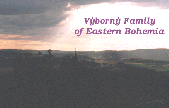
Introduction:
Despite relatively large amount of data collected the problem to
identify the earliest roots of the Vyborny family has not been
interpreted unambiguously so far. See also
Chronology of early periods
page.
Below are the three main hypotheses as formulated recently by the
Czech genealogist Karel Kysilka based on his extensive archive
research:
A) origin from Klatovy,
B) origin as
field-masters from inside of the Kutna Hora region,
C) origin from
"Dvoraks" residing in the (Nemecky/Havlickuv) Brod
region.
Even other hypotheses are not excluded too, however (at least the origin of the earliest Vybornys of Pisek region traceable in Berni rula 1654 should be understood).
Some of the earliest records available for MUDr.Josef(*1864) Vyborny (deposited now in The State Regional Archive Prague) have been searched thru again and re-evaluated using special experience of K. Kysilka to complete the A) and B) items.
Results obtained are inspirative because both some suggestions where to search further and an idea where to look for "the Klatovy Tailor's Book" (the genealogist's comments written in italics).
Some of the presented hypotheses need not to be exclusive only (in particular e.g. as to the "Wegborneg/Cerny" legend).
It is known,
Vaclav Vyborny bought a house in Klatovy in 1597 (#137
in the present Kramerius Street). He bought it from Hons the tailor
for 100 kops. The house was as his possession still in 1619.
Vaclav's widow has kept it until 1640. During the 30 year's war
Klatovy suffered greatly - the citizens had to pay a lot to the
Emperor's army and they had to be re-catholized.
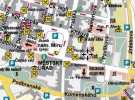 Position of the former house No.137 Krameriova street, Klatovy indicated
in the map by the black circle sign
(
click on to enlarge the map)
--->
Position of the former house No.137 Krameriova street, Klatovy indicated
in the map by the black circle sign
(
click on to enlarge the map)
--->
Another map and pictures
here
In 1636 the
Jesuites came to Klatovy. They have settled in one town's house
which they adapted as the school and the college. The number of
classes there increased from one to six during 1636-1647. Lack of
space was the reason for the Jesuites to consider building of a
greater college and school. The houses around the Black Tower and
the Church were confiscated for this purpose.
If Vaclav Vyborny has had some children, they had to left Klatovy as
Vaclav's widow is known to be the owner of the house (#137) in 1640.
We do know Vaclav Vyborny really has escaped from the house in 1633.
He declared before the Municipal Council: "not because of pride but
because of hardships, he has gone because it was unbearable for
him ...". This sentence perhaps concerns to the son of that Vacslav
who bought the house in 1597. The date of birth of this Vaclav's son
should correspond to the time when [the father] has settled in the
new house and opened his tailor's business there. Vaclav Jr. could
have been born in the period 1595-1610. Though he was a protestant
originally [after re-catholization] he joined to co-operate with the
Jesuites. And those Jesuites could have sent him to Kutna Hora,
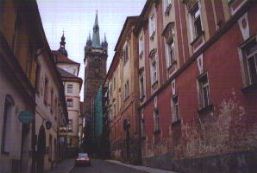
|
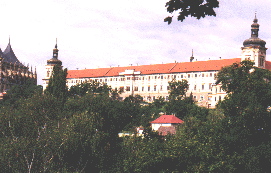
|
where an another complex of the Jesuit college, school and estates has been built since 1633. The Emperor allowed to build this [=of Kutna Hora] college even in 1624 and has granted the Jesuites with the [war] confiscated estate of Kresetice to which belonged the surrounding villages: Kresetice, Predborice, Krasinovicky, Krupa, Perstejnec, Neskaredice, Bylany, Pabenice, Chrast and also the yards in Pritoka, Pucher and this one directly in the village of Kresetice.
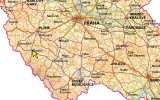
The pater Jan Loubsky was the Rector of the K.Hora's Jesuit College in 1651. He wrote the list "Societatis Jesu" of persons being in service for the College at the yard of Kresetice on Mar 19, 1651. He had to prepare it according the Decree of Nov 16, 1650 ordering all the district representatives throughout the Bohemia to list all the inhabitants according the (catholic) religious faith. The obligate columns of such lists were: name - position - job - religious faith. These lists are the second the most important archive source of the half of 17th century, completing so called "Berni rula" from 1654. The latter listed the owners of some property, however, only.
According to the above mentioned list of the persons working for the K.Hora Jesuit College the following 6 professions were included there: a cook, a baker, a shoemaker, a tailor, a stoker, a gardener. As the gardener certain Vaclav of Klatovy was listed there. He was described as a free-man ["non-subject to anybody"], aged 46 which corresponds to the birth around 1605. Together with him his wife Katerina [Catharina] the washer-woman aged 31 and his son Tomas aged 2 lived in the houses belonging to the College. They had even other children, probably - those aged over 7 were included in this list only, however. The reason of the exclusion in the case of Thomas is not known - it could be because some mistake, too, perhaps.
LITERATURE:
(1) P.Vlcek et.al.: "Encyclopaedia of Czech Monasteries" (in Czech)
(2) The list of the subjected persons according to their religious
faith, 1651, The Caslav region, Part I
(3) the excerpts regarding "the tailors of Klatovy" of presently
unknown origin could have been made from the following book: Dr.J.
Vancura: "History of the former Royal Town of Klatovy" (in Czech)
(4) Dr.A.Podlaha: "History of Jesuit Colleges in Bohemia and
Moravia" (in Czech)
(5) T.Bilek: "Incomes and estates of Jesuit Colleges", Proc.Royal
Sci.Soc., 1889 (in Czech)
Notes:
The further search should concern to the K.Hora registers, again. It
should be checked for any occurence of the surname KLATOVSKY [= of
Klatovy - in Czech], whether of the first name Vaclav or of any
other. Also notes about all the persons named Frydrich should be
excerpted and possible dependences considered.
August 2001, Karel Kysilka
Contact: cv@vyborny.com
Last
updated: Aug 11, 2002